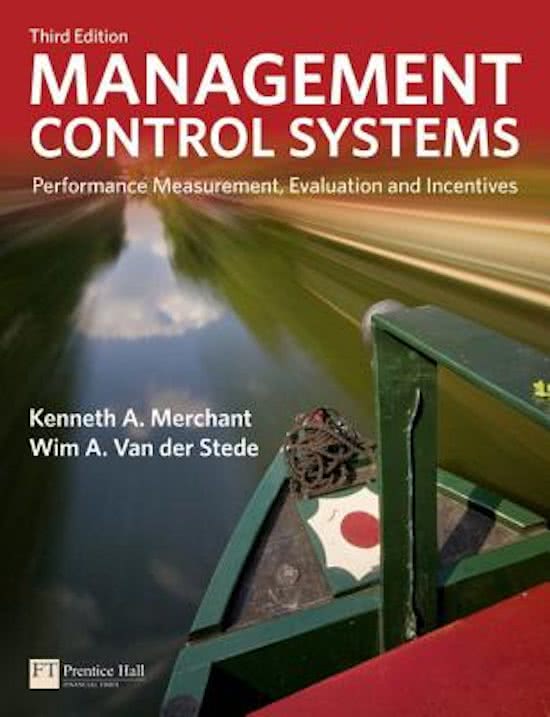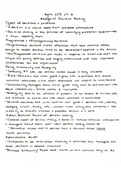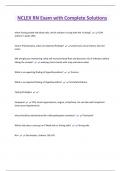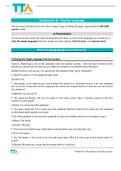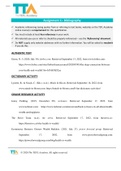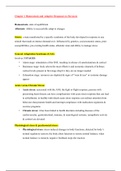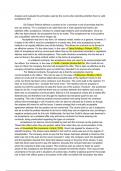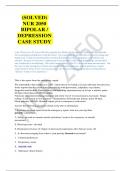Management Control Systems:
Performance Measurement, Evaluation
and Incentives, by Kennet A. and (2)
Lecture slides and comments by the
lecturer, B. van den Berg and K. Tesselhof,
of Management Control 2.
Management
Control 2
Summary
Kathleen Gaillot
,Table of Contents
Management Control 1 General Summary / Overview .......................................................................... 1
Chapter 10: Financial Performance Measures and Their Effects............................................................ 2
10.1 Value Creation............................................................................................................................. 3
10.2 Market Measures of Performance .............................................................................................. 3
10.3 Accounting Measures of Performance ....................................................................................... 3
10.4 Investment and Operating Myopia ............................................................................................. 4
10.5 Return-on-Investment Measures of Performance ..................................................................... 4
10.6 Residual Income Measures as a Possible solution to the ROI Measurement Problems ............ 5
Chapter 13: Corporate Governance and Boards of Directors................................................................. 6
13.1 The Sarbanes-Oxley Act of 2002 ................................................................................................ 7
13.2 Board of Directors ....................................................................................................................... 7
13.3 Audit Committees ....................................................................................................................... 8
13.4 Compensation Committees ........................................................................................................ 9
Chapter 14: Controllers and Auditors ................................................................................................... 10
14.1 Controllers................................................................................................................................. 10
14.2 Auditors..................................................................................................................................... 11
14.2.1 Audits ................................................................................................................................. 12
14.2.2 External and Internal Auditors ........................................................................................... 12
14.2.3 Types of Audits ................................................................................................................... 13
Chapter 15: Management Control-Related Ethical Issues and Analyses .............................................. 14
15.1 The Important of Good Ethical Analyses .................................................................................. 14
15.2 Ethical Models ........................................................................................................................... 14
15.3 Analysing Ethical Issues............................................................................................................. 15
15.4 Why do People Behave Unethically? ........................................................................................ 15
15.5 Some Common Management Control-Related Ethical Issues .................................................. 16
15.6 Spreading Good Ethics Within an Organization ........................................................................ 17
Risk Management ................................................................................................................................. 18
Exam Notes ........................................................................................................................................... 20
Appendix 1: COSO Cube ........................................................................................................................ 21
Important items, as hinted at by the lecturer
Semi-important items, as covered in class
Text in dark yellow represents information extracted from the book (not present on slides)
1
,Management Control 1 General Summary / Overview
Action Controls take any of four basic forms:
Behavioural Constraints Preaction Reviews
Makes it more difficult for employees Involves the scrutiny of the action plans of the
to do things they shouldn’t do employees being controlled. (Dis)Approvals.
Physical, Administrative, Separation Budgets, Investments, Huge Contracts
of Duties, Poka-Yokes
Action Accountability Redundancy
Procedures, Policies, Codes, direct Considered an action control because it increases
supervision, internal audit… probability that task will be satisfactorily completed
Actions for which employees are held (Redundancy = assigning more employees to a task
accountable can be communicated than is necessary. Common in computer facilities, 4
either - Administratively: rules, Eyes Principle, Back-up Systems, High Risks Complex
policies, conduct code. - Socially: Decisions
monitoring, mystery shoppers…
Personnel Controls: (1) Selection & Placement (2) Training (3) Job Design & Necessary Resources
(also: firing as needed). Cultural Controls: (1) Codes of Conduct (2) Group Rewards (3) Employee
Rotations (4) Physical & Social Arrangements (5) Tone at the Top
$$$$ Direct costs of MCS: Design & implement MCS (internal audit, bonuses, time) / Compliance
Indirect costs: Behavioural displacement (gamesmanship & operating delays), negative attitudes
The Four Types of Financial Responsibility Centres
Revenue centre Cost centre Profit centre Investment centre
Corporate/highest level is always an investment centre (evaluated on everything), A product/service
division (business unit) is always a profit centre (but not held accountable for investments) a profit
centre (division manager) may be responsible for a cost and revenue centres further down the
organizational structure (manufacturing and marketing), a manufacturing, financial or administrative
department only creates costs and no profit and is thus a cost centre, and a sales unit or account
management department is all about making the end sales and getting money out of the customers,
without being charged for the production costs etc, thats a revenue centre.
Profit vs revenue centres, the
difference?
Profit centre = revenue + cost. Like say
a business unit for product X is a profit
centre. That profit centre manages all
the planning for all lower management
with taxing and everything. Under
Division X, theres a revenue centre
that consists of sales people that are
making money. That sales department
is only held accountable for revenue,
nothing else. The cost of reaching out
to the customer, paying for the ads
and so on will be accounted for by the
profit centre (division managers).
See Appendix 1 for COSO cube
1
,Chapter 10: Financial Performance Measures and Their Effects Book p.454
At managerial levels of organizations, both at the corporate and entity levels, job responsibilities are
both broad and varied. The list of measures used in practice to motivate and evaluate managers’
performances is long. They are classified into three broad categories:
- Two of these categories include summary, single-number, aggregate, bottom-line financial
measures of performance, (Summary measures and Bottom-line impact)
❖ Market measures: reflecting changes in stock prices or shareholder returns.
❖ Accounting-based measures: defined by rediual terms (net income after taxes,
operating profit, reditual income, economic value added) or ratio terms (return on
investment, return on equity, return on net assets).
↑ These measurement categories represent financial measures of performance because they are:
- Denominated in currency, such as dollars (e.g. Quarterly profits or earnings of $1.7 million);
- They are a ratio of financial numbers, such as $0.12 earnings per share (eps) or 12% return
on equity (roe);
- They represent a change in financial numbers, such as 11% earnings growth.
- The third includes combinations of measures. i.e. both summary market and accounting
measures or the use of one or both types of summary measures plus some
❖ disaggregated financial measures (e.g. revenues, expenses) and/or
❖ nonfinancial measures (e.g. market share, sales growth, inventory turnover,
customer satisfaction). (see chapter 11)
Economic Income:
• Is not accounting income
• Changes in value of company over time
• Based on (expected) discounted future cash flows
• Cost of capital & risks
Types of Financial Performance measures:
Chapter 10
What are the criteria for (financial) measures?
• Congruent • Controllable • Precise • Objective
• Timely • Understandable • Cost efficient (from chapter 2)
2
,10.1 Value Creation performance measures should
What is the primary objective of a for-profit organization? go up when value is created and
To maximise the value of the firm (subject to constraints i.e. go down when it is destroyed
laws and employees, customers and stakeholders concerns.
→ (shareholder) value creation: long term, future oriented, economic income
Short-term accounting profit and return measures provide imperfect, surrogate indicators of changes
in firm value.
The change in firm value over any given period is called economic income. Economic income is
different from accounting income (i.e. revenues less expenses, both as defined by accountants).
10.2 Market Measures of Performance
Market measures of performance are based on the changes in the market value of the firm, and/or
return to shareholders.
The value created is measured for any period (yearly, quarterly, monthly) as the sum of the dividends
granted to shareholders in the measurement period +/- the change in the market value of the stock.
For publicly traded companies, market value is the best indicator of firm value.
- Provides direct indications of the amount of value that has been created or destroyed.
“Shareholders get paid when managers create equity value, not when managers check off items on to-
do lists. To align manager interests with owner interests, pay managers the same way shareholders
are paid” = Link results control to shareholder values. (For the top management team only, however
may still be difficult to have a direct impact on shares) Solutions:
• Relative performance evaluations. Managers can be held accountable for generating market
returns greater than those of the overall market or greater than those of the closest peer
group.
What kind of Market measures?
Market Value Number of shares x share price
Return to shareholders Sum of dividends paid plus change in market value of the stock
Advantages and disadvantages of Market measures
Advantages Disadvantages
• Congruence (goals of owners & • Controllability (limited, only for top management)
managers) • Not about realized performance (heavily
• Timely (publicly traded) influenced by future expectations instead)
• Precise (accurate) • Congruence failure (not all information is available
• Objective (not manipulated) for the market)
• Understandable • Feasibility (limited to public traded profit
• Cost effective (being listed is costly!) companies)
10.3 Accounting Measures of Performance
What kind of (summarized) Accounting measures are known?
Accounting-based (summary/bottom-line) performance measures come in two forms:
Residual Accounting profit: e.g. net profit, operational income, EBITDA, tax
Ratio Accounting return: e.g. return on equity, return on investment,
3
, Advantages and disadvantages of Accounting measures
Advantages Disadvantages
• Timely • Transaction oriented
• Precisely (relatively) • Measurement methods
• Congruence (profit max) • Conservatively biased
• Controllable (at all levels) • Ignorance of changes in (some) value and risks
• Understandable (basic education for • Ignores costs of (equity) capital
managers) • Focus on past
• Inexpensive (systems in place)
10.4 Investment and Operating Myopia
Investment myopia stems from two problems: Intangible assets:
(1) Conservative bias investments in e.g. R&D, HR
(2) Ignoring of intangible assets with predominantly future systems, customer goodwill
payoffs.
The quest for short-term profits and returns sometimes induces managers to engage in manipulative
earnings management practices, i.e. not booking “operating expenses” immediately, but instead
pushing them into the future as “capital investments.” Another approach is channel stuffing: involves
boosting near-term sales by extending lower prices to distributors, encouraging them to load up while
potentially hurting later sales. These are examples of operating myopia. ↓
Investments and Operating Myopia
• Managers think short term (rewards)
• Accounting rules are conservative: revenue recognition, costs of intangible assets
• Investment myopia
• Earnings management
• Operational myopia
10.5 Return-on-Investment Measures of Performance
Divisionalized isn’t synonym of decentralized: An organization is said to be decentralized when
authority for making decisions is pushed down to lower levels in the organization. All divisionalized
organizations decentralize authority to an extent. All divisionalized organizations are decentralized,
but not all decentralised organizations are divisionalized.
When decentralization is done along functional lines of authority (i.e. marketing, finance), the
responsibility centres are usually cost and revenue centres, not profit or investment centres (divisions)
ROI Measures of performance (often used for managers of responsibility centres in divisionalized
organizations)
• Divisionalized organizations:
o Local managers become experts in their specialized markets, and they are able to
make good decisions more quickly
• Decentralized decision making
o The time of top management is freed so that they can focus on major strategic
decisions.
• Large and complex
• Not suited for actions controls
• Relying on ROI measures in results control
4

